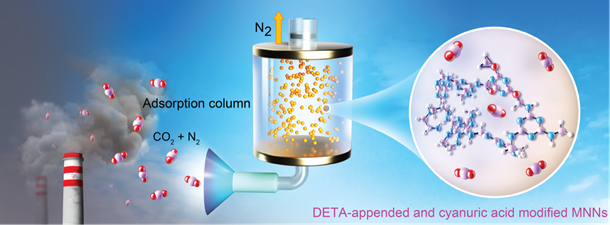Chemists from the University of California, Berkeley, Stanford University, Texas A&M University and the Lawrence Berkeley National Laboratory have developed a straightforward way to remove carbon dioxide (CO2) from exiting flue gases such as from tailpipes, fireplaces, smokestacks and furnaces. They made a porous material from melamine, an inexpensive polymer that is the main component of Formica, that is able to efficiently capture CO2 from flue gases.
The reduction of fossil fuel burning is vital for achieving net zero carbon emissions by 2050. However, carbon capture is not easily commercially viable, with current approaches depending on large amounts of energy to allow the CO2 to be concentrated and stored underground.
As reported in Science Advances [Mao et al. Sci. Adv. (2022) DOI: 10.1126/sciadv.abo6849], this new material is simple and inexpensive to make, as it based on melamine powder being treated with formaldehyde to produce nanoscale pores in the melamine to absorb CO2. Adsorption was also much improved with the addition of diethylenetriamine (DETA) to bind CO2. Adding cyanuric acid during the polymerization reaction also significantly increases the pore size and improves CO2 capture efficiency.
The resulting melamine nanoporous networks (MNNs) hold potential for reversible CO2 capture due to their robust flake-like structures, high surface areas, tunable surface chemistries and industrial-scale capture capabilities. Such melamine-based materials use much cheaper ingredients and are more energy efficient than most metal organic frameworks (MOFs), which have recently been used to remove CO2 from flue gases.
The design of a sustainable material for long-term CO2 capture, and identifying the fundamental mechanism underlying the interaction of frameworks and gas molecules, required a combination of cheap materials with dynamic combinatorial chemistry, as well as understanding how these chemical functionalities are located in space to enhance CO2 capture.
Using solid-state nuclear magnetic resonance techniques, the mechanism of the reaction of the amorphous networks with CO2 was shown in atomic-level detail to produce a high-performance, solid-state network family. The process for synthesizing the material could be scaled down to capture emissions from vehicle exhaust or other movable sources of carbon dioxide. As first author Haiyan Mao said: “This work creates a general industrialization method towards sustainable CO2 capture using porous networks”.
The team hope to further develop very cheap materials for direct air capture of CO2, and to design a future attachment for capturing automobile exhaust gas, or even for buildings or a coating on furniture. They would also like to deploy the materials at pilot scale for possible applications in power plants, although to ensure such pilot studies of carbon capture, national governments will have to decide these important efforts warrant attention through legislation.
“This work creates a general industrialization method towards sustainable CO2 capture using porous networks”Haiyan Mao
 Melamine nanoporous networks (MNNs) hold potential for reversible CO2 capture
Melamine nanoporous networks (MNNs) hold potential for reversible CO2 capture